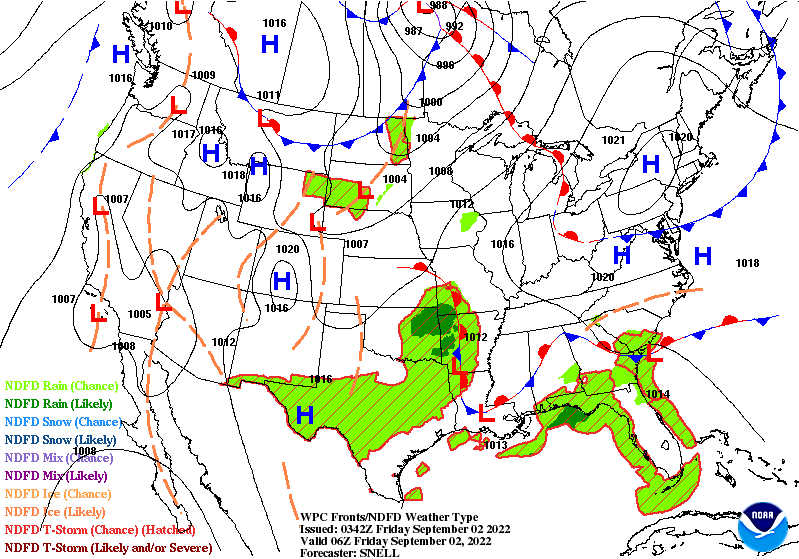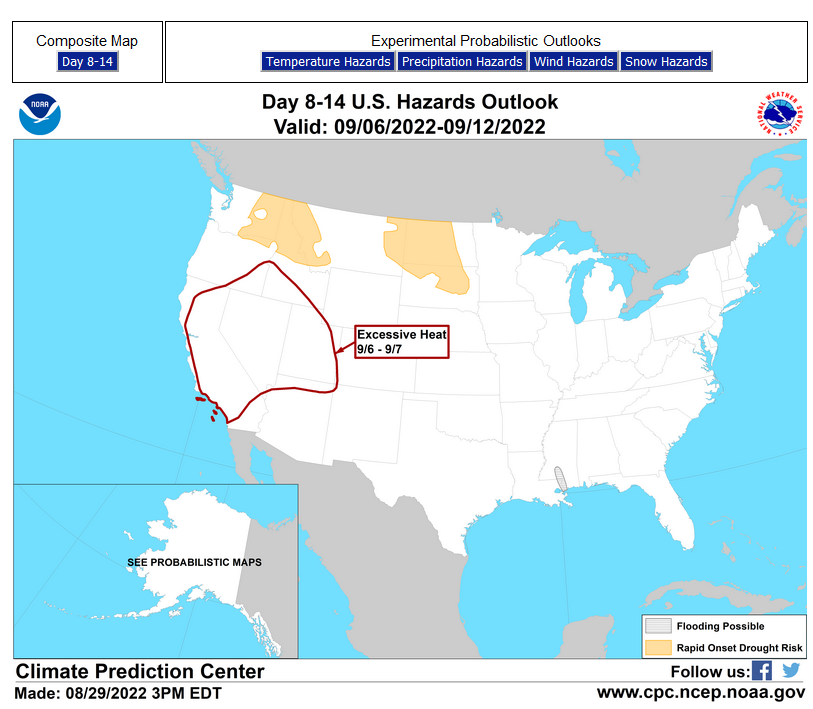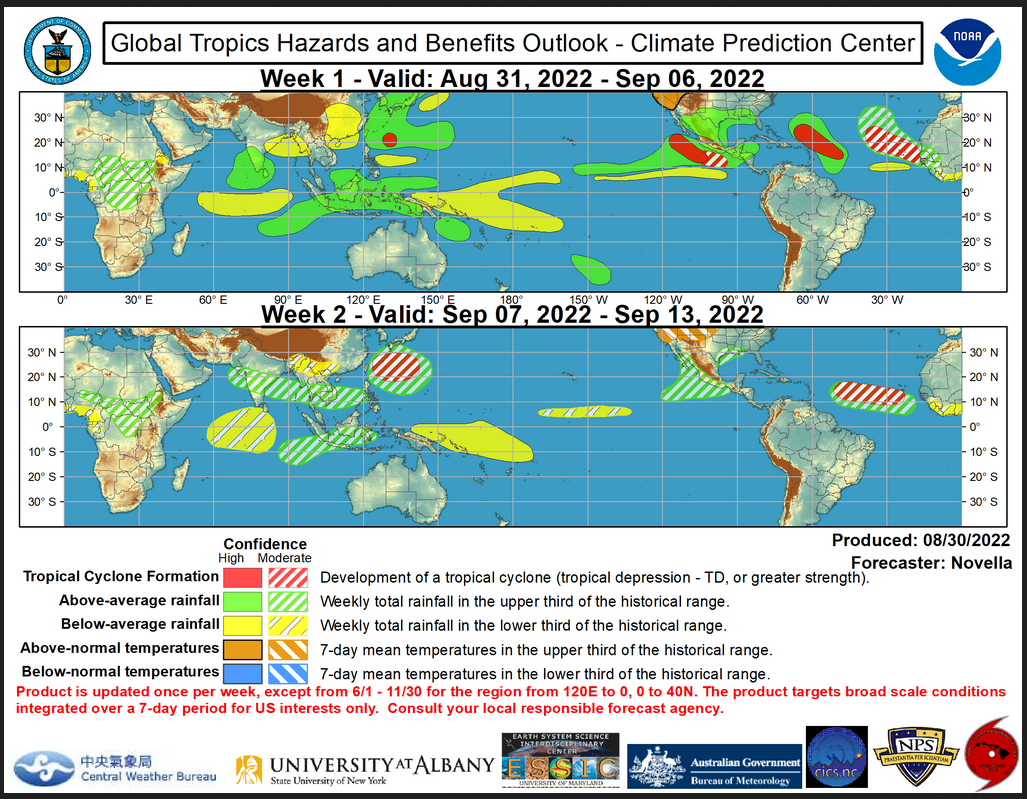Here is what we are paying attention to tonight and the next 48 hours from this evening’s NWS Forecast.
...Prolonged and potentially dangerous heat wave continues to expand across much of the West... ...Widespread showers and thunderstorms, including a Slight Risk for flash flooding, forecast from Texas into the Lower Mississippi Valley... ...Cold front to bring fall-like temperatures to the Upper Midwest and Great Lakes..
Continuation of the NWS Short Range Forecast (It is updated twice a day and these updates can be found here.
A prolonged and possibly record heat wave building over the Western U.S. is the main headline as we head into the upcoming holiday weekend (and lasting well into the medium range period as well). Starting in the interior Pacific Northwest, high temperatures in the low to mid-100s are forecast on Friday before the passage of a cold front brings some relief for Saturday. Temperatures will soar into the upper 90s to low 100s for the Northern Rockies and Northern High Plains of Montana on Saturday. These temperatures are upwards of 25 degrees above normal for early September. For the Great Basin, highs will be in the upper 90s to low 100s both Friday and Saturday. The Desert Southwest as well as the Sacramento and San Joaquin valleys of California will see highs in the mid-100s to low 110s, while highs for interior portions of coastal California will be in the upper 90s and low 100s. Numerous record-tying/breaking highs are possible across the entire region and widespread heat-related advisories are in place. The heatwave will pose a high to very high risk to the general population, particularly the elderly and those without adequate air conditioning, due to both the intensity of the high temperatures and duration of the heat wave. Low temperatures will also be well above normal, providing little relief from the heat overnight. The hot temperatures, minimal moisture/low relative humidity values, and sufficient sustained winds of 20+ mph have also prompted a Critical Fire Weather Risk area from the Storm Prediction Center on Friday for south-central Oregon, far northeastern California, and far northwestern Nevada. An weakness/disturbance in the upper-level flow between the ridge to the west and high pressure off the coast of the Carolinas combined with ample tropical moisture flowing northward from the Gulf over a wavy stationary boundary will support the development of widespread showers and storms from Texas east through the Lower Mississippi Valley and into the Southeast through Saturday. Heavier rainfall totals over portions of Texas into the Lower Mississippi Valley will pose the risk of flash flooding both Friday and Saturday. There is a Slight Risk of Excessive Rainfall on Friday for the Arklatex and Big Bend region of Texas as heavier downpours may produce hourly rain rates between 2-3". There is also a Slight Risk for the Texas Gulf Coast into the Lower Mississippi Valley on Saturday for more widespread heavy rainfall. Areal average totals between 1-2" are forecast, with localized amounts between 3-5" possible. Further to the north, the aforementioned cold front over the Northern Plains will continue southeastward into the Midwest and Great Lakes. The passage of the front will usher in much cooler temperatures, with highs only getting into the low 60s for areas around the Upper Great Lakes on Saturday and the low to mid-70s elsewhere in the region. Notably, areas in North Dakota will go from highs in the mid- to upper 90s today (Thursday) to lows in the upper 40s Saturday morning. In addition to the cooler temperatures, the cold front may tap into enough moisture to produce light and scattered precipitation and thunderstorms from the Central Plains to the Upper Great Lakes. Elsewhere, temperatures will be a bit below average across the the South due to the widespread showers and storms, while highs will be near normal from the Ohio Valley into the Mid-Atlantic and Northeast.
Maps that relate the forecast to geography can be found by clicking Here for Day 1 and Here for Day 2.
Here is a 60-hour animated forecast map that shows how the short-term forecast is expected to play out.
If it needs to be updated click here.
HAZARDS OUTLOOKS
Click here for the latest complete Day 3 -7 Hazards forecast which updates only on weekdays. Once a week probably Monday or Tuesday I will update the images. I provided the link for readers to get daily updates on weekdays. Use your own judgment to decide if you need to update these images.
Worldwide Tropical Forecast
(This graphic updates on Tuesdays) If it has not been updated, you can get the update by clicking here
Detailed Maps and Reports for the Western Atlantic and the Pacific Oceans
Below are three maps that summarize the situation for the Atlantic, Eastern and Central Pacific. Additional information can be accessed by clicking HERE
First the Atlantic
Click to view the forecast map and have access to additional information https://www.nhc.noaa.gov/gtwo.php?basin=atlc&fdays=5
Then Eastern Pacific
Click to view the forecast map and have access to additional information https://www.nhc.noaa.gov/gtwo.php?basin=epac&fdays=5
Then Central Pacific
Click to view the forecast map and have access to additional information https://www.nhc.noaa.gov/gtwo.php?basin=cpac&fdays=5
And the Western Pacific
Click to view the forecast map and have access to additional information https://www.metoc.navy.mil/jtwc/jtwc.html
Some Intermediate-Term Outlooks
Links to “Outlook” maps and discussions for three time periods. Days 6 – 10, Days 8 – 14, and Weeks 3 and 4. An outlook differs from a forecast based on how NOAA uses these terms in that an “outlook” presents information from deviation from normal and the likelihood of these deviations.
You have to click on the links because they do not update automatically and I do not want to have stale images in the article. But it is not difficult to click on a link and you get a large image plus a discussion. On Fridays in a separate article, we will show the images and provide a link in this article that article. But remember what you will see is the images as of Friday. But here you can get the current images simply by clicking on them. Then hit the return arrow at the upper left of your screen to return to the article. You will not find this information easily anywhere else.
Right now you can find these maps here (We show them every Friday there but you can click above and find them).
World Forecast for Day 6 (Currently Set for Day 6 but the reader can change that)
World Weather Forecast produced by the Australian Bureau of Meteorology. Unfortunately, I do not know how to extract the control panel and embed it into my report so that you could use the tool within my report. But if you visit it Click Here and you will be able to use the tool to view temperature or many other things for THE WORLD. It can forecast out for a week. Pretty cool. Return to this report by using the “Back Arrow” usually found top left corner of your screen to the left of the URL Box. It may require hitting it a few times depending on how deep you are into the BOM tool. Below are the current worldwide precipitation and air pressure forecasts for six days out. They will not auto-update and right now are current for Day 6. If you want the forecast for a different day Click Here I will try to update this map each day but you have the link so you can access the dashboard and get a wide variety of forecasts.I mostly rely on the reader to interpret world maps. For this map, areas of expected precipitation for the date and time shown are clearly shown. The number of High-Pressure systems shown is called the Wave Number. Maybe I will discuss WN someday. But it shows how many Rossby Waves there are around the World. Sometimes they are hard to count. Counting Low-Pressure systems should provide the same WN. Rossby Waves are the way the temperature distribution of the Planet remains in balance. It is basically the science of fluid dynamics. It can be very helpful in predicting the movement of weather patterns. You can snip an area of interest and move it into MS Paint and enlarge it.
Month to Date Information
Month to date Temperature can be found at https://hprcc.unl.edu/products/maps/acis/MonthTDeptUS.png
Month to date Precipitation can be found at https://hprcc.unl.edu/products/maps/acis/MonthPNormUS.png






